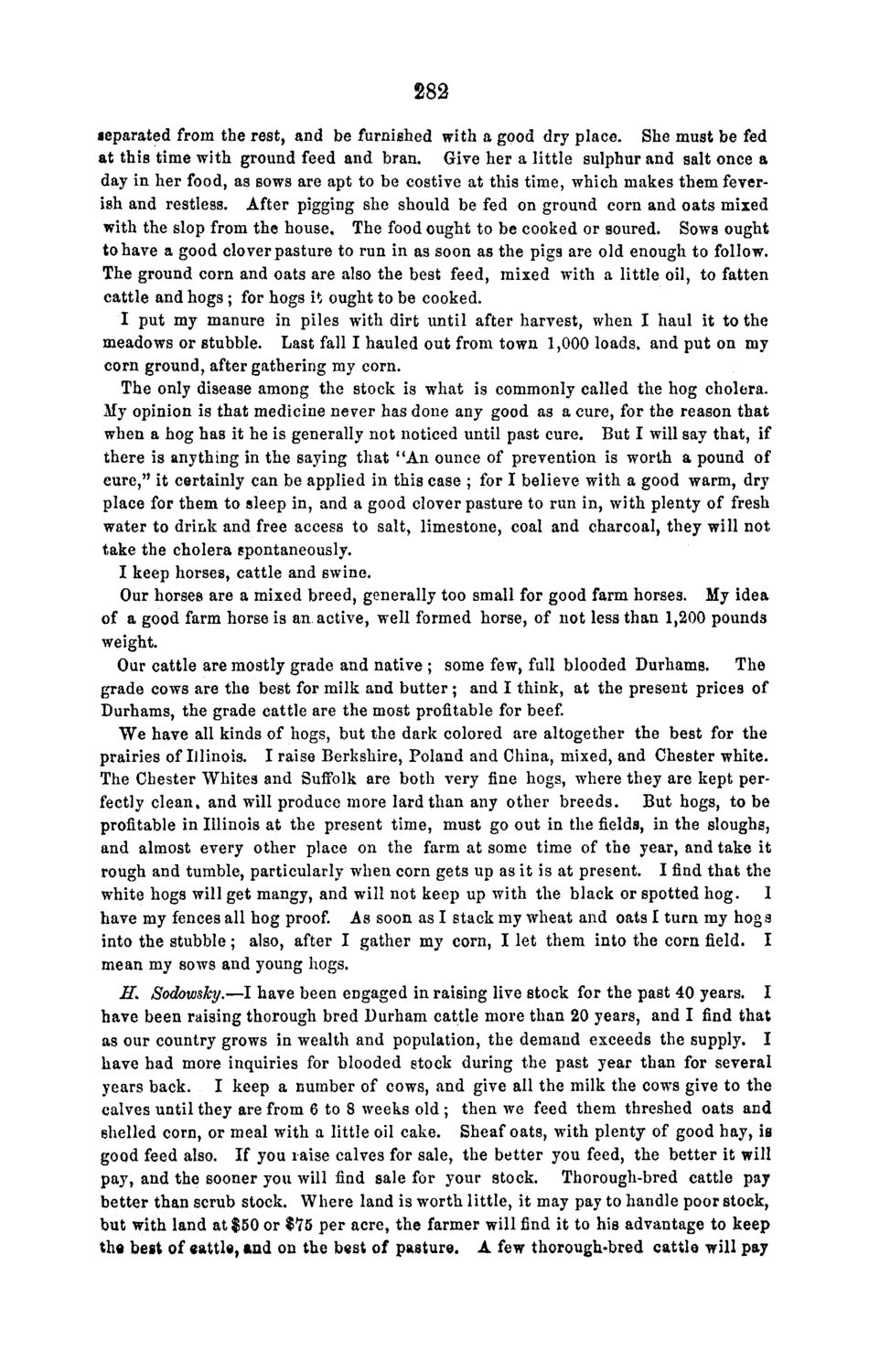| |
| |
Caption: Board of Trustees Minutes - 1868
This is a reduced-resolution page image for fast online browsing.

EXTRACTED TEXT FROM PAGE:
282 separated from the rest, and be furnished with a good dry place. She must be fed at this time with ground feed and bran. Give her a little sulphur and salt once a day in her food, as sows are apt to be costive at this time, which makes them feverish and restless. After pigging she should be fed on ground corn and oats mixed with the slop from the house. The food ought to be cooked or soured. Sows ought to have a good clover pasture to run in as soon as the pigs are old enough to follow. The ground corn and oats are also the best feed, mixed with a little oil, to fatten cattle and hogs ; for hogs it ought to be cooked. I put my manure in piles with dirt until after harvest, when I haul it to the meadows or stubble. Last fall I hauled out from town 1,000 loads, and put on my corn ground, after gathering my corn. The only disease among the stock is what is commonly called the hog cholera. My opinion is that medicine never has done any good as a cure, for the reason that when a hog has it he is generally not noticed until past cure. But I will say that, if there is anything in the saying that "An ounce of prevention is worth a pound of cure," it certainly can be applied in this case ; for I believe with a good warm, dry place for them to sleep in, and a good clover pasture to run in, with plenty of fresh water to drink and free access to salt, limestone, coal and charcoal, they will not take the cholera spontaneously. I keep horses, cattle and swine. Our horses are a mixed breed, generally too small for good farm horses. My idea of a good farm horse is an active, well formed horse, of not less than 1,200 pounds weight. Our cattle are mostly grade and native ; some few, full blooded Durhams. The grade cows are the best for milk and butter; and I think, at the present prices of Durhams, the grade cattle are the most profitable for beef. We have all kinds of hogs, but the dark colored are altogether the best for the prairies of Illinois. I raise Berkshire, Poland and China, mixed, and Chester white. The Chester Whites and Suffolk are both very fine hogs, where they are kept perfectly clean, and will produce more lard than any other breeds. But hogs, to be profitable in Illinois at the present time, must go out in the fields, in the sloughs, and almost every other place on the farm at some time of the year, and take it rough and tumble, particularly when corn gets up as it is at present. I find that the white hogs will get mangy, and will not keep up with the black or spotted hog. I have my fences all hog proof. As soon as I stack my wheat and oats I turn my hogs into the stubble; also, after I gather my corn, I let them into the corn field. I mean my sows and young hogs. H* Sodowsky.—I have been engaged in raising live stock for the past 40 years. I have been raising thorough bred Durham cattle more than 20 years, and I find that as our country grows in wealth and population, the demand exceeds the supply. I have had more inquiries for blooded stock during the past year than for several years back. I keep a number of cows, and give all the milk the cows give to the calves until they are from 6 to 8 weeks old ; then we feed them threshed oats and shelled corn, or meal with a little oil cake. Sheaf oats, with plenty of good hay, is goqd feed also. If you raise calves for sale, the better you feed, the better it will pay, and the sooner you will find sale for your stock. Thorough-bred cattle pay better than scrub stock. Where land is worth little, it may pay to handle poor stock, but with land at $50 or $75 per acre, the farmer will find it to his advantage to keep the best of cattle, and on the best of pasture. A few thorough-bred cattle will pay
| |